
Physarum polycephalum or the more common name slime mould but also known as the blob. I have briefly mentioned the slime mould in my previous post HERE: "Slime mould is an Amoebozoa and it is described as "technically not a plant, animal or fungi" (Stieg, 2019) but is very smart and can solve puzzles, learn and take decisions.."

(Rodríguez-Ezpeleta & Philippe, 2009)
I have done some initial research to understand the blob before my experiment. I read about its ability to find a way by analysing the space around it (Slime Mould Senses, n.d.). "In the first stage of their life cycle, they exist as groups of individual cells that move around in the soil. They are so small they are invisible to the naked eye. Then they come together as a large mass in the plasmodial stage where they form into blobs or intricate patterns that have a slime-like appearance, hence the name slime mould." (Childsplayabc, 2022)
There are certain chemicals or food that it likes and dislikes. Oats seem to be the food that it really likes. It is also responding to light and can't dry out so a shaded and damp area is the best solution for it. If the watch conditions are tough they will "harden their cell walls and retreat into a tight little cluster to protect themselves." (Childsplayabc, 2022) When it comes to finding its way it lays down a chemical trail so when it solves a maze it already knows that it is not worth looking at that place again. In nature, they are known as the cleaners, in search of bacteria and natural yeast to feed on.
"Durotaxis is the ability to sense how hard or tough a surface is. Slimes usually like something hard but not too hard - they'll pick a piece of wood over a rock or a loose pile of moss.
We’ve known for a long time that it’s attracted to some things (oats, sugar, protein) and avoids others (salt, caffeine, high pH) – a behaviour called chemotaxis but she showed that it’s possible to teach a slime to approach something it would normally avoid in return for food – and that it will keep that memory for a year or more." (Slime Mould Senses, n.d.)
Experiment:
I started by thinking about how I could make the slime mould grow over my site, so I built an acrylic box where some air still could come through. The pictures below is from the building, activating and setting up the stage.
Starting the project has not been easy, once my slime mould arrived, I needed to get everything organized and set up. I needed to send in a risk assessment form and get a room free for several days to have the photoshoot. When the risk assessment was confirmed we started to set everything up, it took almost a full working day to get the camera to focus and not to have any disturbing reflections in the glass, and just to figure out how everything would work. Once I activated the slime mould it took about 3-4 hours and a change of environment before it started to grow. It really thrived in my bathroom where the petri dish could have good humidity throughout the evening and night. But because the set-up is in one of the photo rooms in the university I had to take it back and the ventilation is very good here so my next challenge is to keep it humid enough in the container/frame that I built for this project. Almost a full day has passed again and there is very small movement from the slime mould, I have been laying out a pattern of oats for it to find and create a path to and around. I hope that it will survive the night and have enough moisture to keep on growing. It is at least a cool and relatively shady room with the setup so that should be good at least.
The blob survived the night and has mostly moved towards the wet paper I put in there for moisture. The oats were not as attractive as the wet paper. I have been rethinking how I should make it move towards the oats so I am trying different things in the four different places. to see how it moves and what works the best. For the night I put one piece of paper in the blank spot to see if it grows better on the wet paper.
In the morning my theory was true and it has been growing much on the wet paper and we can see the beautiful patterns it is creating. I am still trying different things, it also liked the wet tissue paper I put down so I am trying to attract it in different ways to move towards the oats.
After a week's time, I have finally managed to find a way for the slime mould to grow and that really reflects in my time-lapse video. Over 3000 photographs later you can see the slow start and explosive end. It is a remarkable and beautiful way it moves through the space, which I have been very inspired by in my design. The patterns and the flowy way it moves around the space and the way it finds its way to the oats and the moist paper. I have realized in this experiment that you can not control nature, it will find its way to live and thrive under the correct circumstances. That is why we have some types of animals and plants in Southsea as an example. They live and thrive in that climate and have adapted to that for a very long time.
This is the timelapse video of my slime mould growing for a week. It is a very slow start and explosive end. With time you can also notice how I learned how to make a good environment for it to grow.
I took a few micro photos to study the movement and pattern closer. It is really fascinating to see all of the patterns it creates and you can see where it moves by spreading out to then choose the most efficient way.
In this video, I have been mapping one pattern of the way the slime mould has been moving. The oats are representing the trees that will grow on the site and see how the structure could work around to benefit the trees and connect animals and plants to these places.
References:
Stieg, C. (2019, October 23). “The Blob”: This mysterious “smart” slime can solve puzzles and make decisions. CNBC. https://www.cnbc.com/2019/10/23/the-blob-slime-mold-physarum-polycephalum-characteristics.html
Slime Mould Senses. (n.d.). https://warwick.ac.uk/. https://warwick.ac.uk/fac/sci/lifesci/outreach/slimemold/facts/senses/
Rodríguez-Ezpeleta, N., & Philippe, H. (2009). Phylogenomics. In Elsevier eBooks (pp. 633–643). Elsevier BV. https://doi.org/10.1016/b978-012373944-5.00013-4
Childsplayabc. (2022, October 24). 8 Slime mould activity ideas + Fun facts. Childsplayabc ~ Nature Is Our Playground. https://childsplayabc.wordpress.com/2021/07/13/slime-mould-activity-ideas/









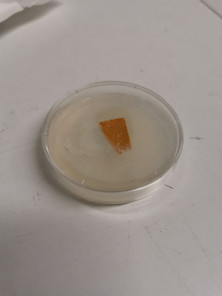







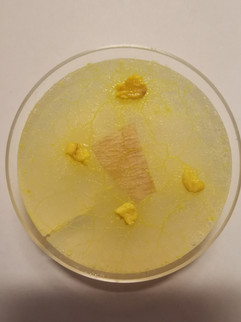

















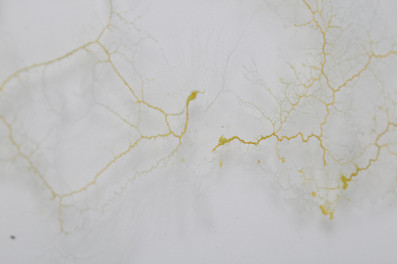









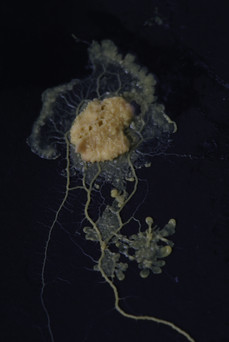









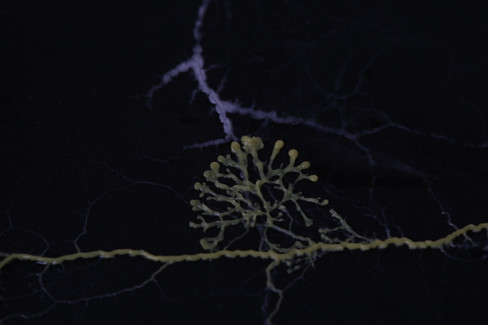












Comments